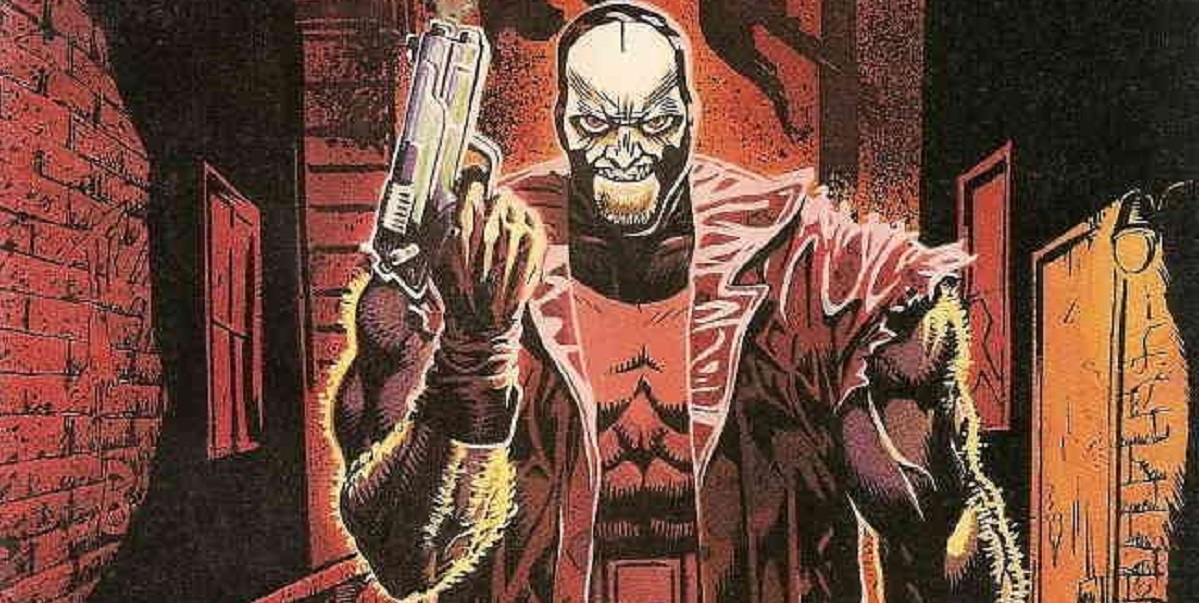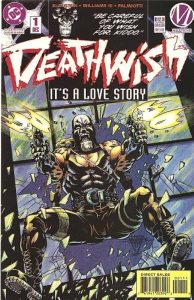I usually try to pick something for the column that is still readily available. Even if it’s only available digitally. To make it relatively easy for folks to check out, if they’re so inclined. As near as I can tell, today’s pick is not in print in any form any more. It’s not collected, and it’s not available on Amazon/Comixology digitally, which is a shame because, not just for content, it holds an important place in Milestone’s history as its first mini-series.
“You don’t get it, kiddo! This isn’t a game.”
Deathwish is a four-issue series from Maddie Blaustein, Yves Fezzani, JH Williams III, Jimmy Palmiotti, James Brown, and Joseph Daniello. It features the titular character, an unhinged vigilante from Hardware intent on mainly killing sex criminals, but he’s more of an incidental force in the story. The main focus is on Lt. Marisa Rahm, a transgender cop, and her vendetta with Boots, who maimed her lover, and is a general terror on the trans community in Dakota.
The story’s overall quite fascinating. It blends Rahm’s hard-boiled narration with a kind of extreme take on the Punisher motif, and explores weird art crimes that target the trans community. There are some laughable action hero clichés in the dialogue. And a ’90s representation of gender identity, complete with outdated terms including what’s now considered a slur. Though it is amazing that this came out in 1994. Written by two trans authors, the late Blaustein and Fezzani. It emphasizes the important work from diverse voices that Milestone was dedicated to.
And yet the reason why I came across it was because it has early artwork from JH Williams III.
“Freeze, twisto!”
The early work from Williams is interesting. I’m pretty sure I had at least one of the early issues of Blood Syndicate that he drew. I know that I have his Judge Dredd issues. Yet I don’t think it was until his Batman work that I really noticed that it was his art. Likely because the early work is vastly different, seemingly dependent on who was inking him at the time and as he developed and refined his style.
With Deathwish, and Jimmy Palmiotti inking him, I see a refinement of some of the exaggerated character designs, a focus on shadows, and a hint of the style that Williams would develop. What’s kind of funny is that while the next period of Williams’ art reminds me a bit of Tony Harris, this here I find reminiscent of a few of Harris’ other Gaijin Studios members, Jason Pearson, Cully Hamner, and Brian Stelfreeze. Pearson and Hamner in regards to character shapes, Stelfreeze in the angular shading lines. I don’t know if any of that was intentional, or if there’s an influence of all of them that I’ve missed, but it looks good.
There’s even a hint at the more elaborate layouts that would become a staple of Williams’ storytelling here in the third issue. In a nightmare sequence, he uses an inventive use of blood pools for the panels. Coupled with James Brown’s darker painted colours and a few shifting styles for narration boxes and word balloons by Joseph Daniello, the visuals for this gritty crime drama are solid.
“Just blow out the candles and make a wish.”
I may have originally picked up Deathwish by Blaustein, Fezzani, Williams, Palmiotti, Brown, and Daniello simply for early work from an artist I love, and I found a compelling story in its own right, delving into gender identity in a way that feels unique and still relevant. It’s a bit rough around the edges, though that’s part of its charm. I don’t know if the series will ever be reprinted, but with a renewed interest in Milestone, I can hope.
Classic Comic Compendium: DEATHWISH
Deathwish
Writers: Maddie Blaustein & Yves Fezzani (plot assist)
Penciller: JH Williams III
Inker: Jimmy Palmiotti
Colourist: James Brown
Letterer: Joseph Daniello
Publisher: DC Comics / Milestone
Release Date: November 10 1994 – February 9 1995
Read past entries in the Classic Comic Compendium!












whoa, I didn’t realise the voice actress of Meowth wrote comics, that’s amazing.
Comments are closed.